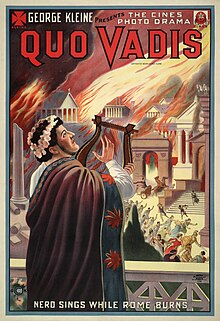Quo Vadis (novel)

Quo Vadis? is a novel by the Polish writer Henryk Sienkiewicz , which describes the beginnings of Christianity in Rome at the time of Nero . It was first published in 1895. Sienkiewicz was inspired by an old legend about an encounter between the apostle Peter and Jesus (see Quo vadis ).
content
The novel tells the love story between the young patrician Marcus Vinicius and Lygia, a king's daughter of the Lygian people , who came to Rome as a hostage. She is a Christian . Gradually the lovers get caught up in the maelstrom of the persecution of Christians in 64 under Nero .
Lygia and the Apostles Peter and Paul , who are currently in Rome, are described as prototypes of Christians . Nero , Poppaea Sabina and Tigellinus appear as their opponents . Other important figures are Petronius , who holds the rank of chancellor in the novel, as well as the retired general Aulus Plautius and his wife Pomponia Graecina (Lygia's adoptive parents).
background
The novel was a bestseller shortly after its publication . Only the atrocities described in detail in the chapters about the execution of Christians (including being torn by wild animals, use as living torches), as they are also shown quite drastically in the 1951 film, were controversial . But here Sienkiewicz follows a historiographical model, the chapter on the persecution of Christians in the " Annals " of Tacitus . Otherwise the novel is historically correct as a whole. It is pre-Christian and ends with an indication of the further development of the Church in Rome.
At the time the novel was written, Poland , the author's homeland, was divided between the Russian Empire, the German Empire and Austria-Hungary ( Polish partitions ). This should help explain the motive of oppression and persecution. For Sienkiewicz, the main female character "Lygia" also symbolizes oppressed Poland, because the Lygians settled in the area of later Greater Poland at the historical time of the novel .
Some of the protagonists are historical people. Marcus Vinicius, Lygia and Ursus, however, were invented. Pomponia, the wife of Aulus Plautius , has been shown to have been accused of belonging to a hostile religion (presumably Christianity, but undetectable) but found innocent by a family court.
Sienkiewicz received the Nobel Prize for Literature in 1905 , Quo vadis? was a major reason for this.
German-language editions
- Quo Vadis? . New edition based on the translation by J. Bolinski, revised edition by Marga and Roland Erb with a follow-up and annotation. dtv, Munich 2016.
- Authorized translation by J. Bolinski, revised edition by H. Feodorowski, Globus, Berlin around 1910.
- Translation by Victoria Eggers-Zwierzchowska , Riga 1899.
- Translation by Kurt Harrer , Union Verlag, Berlin 1958.
- Translation by Paul Seliger , Leipzig undated ( full text at Zeno.org ).
- Translation by Wilhelm Cremer , Berlin undated ( full text at Projekt Gutenberg )
Film adaptations
The novel was made into a film for the first time in 1901 and several times thereafter. The Italian film adaptation by Enrico Guazzoni from 1913 became the first major monumental film in film history. The best known was the Hollywood film from 1951 , which - except for the very end (in the film, Nero, played by Peter Ustinov , is forced to commit suicide immediately after the persecution of Christians ) - can be regarded as a rather faithful film adaptation (director Mervyn Le Roy ).
In 1985 an Italian television series was made with Klaus Maria Brandauer as Nero (directed by Franco Rossi ). Jerzy Kawalerowicz presented a Polish adaptation of the historical novel in 2001.
- 1901 Quo Vadis? (Quo Vadis?), Ferdinand Zecca
- 1910 Quo Vadis? (Au temps des premiers Chrétiens), André Calmettes (Film d'Art (Pathé))
- 1913 Quo Vadis? (Quo Vadis?), Enrico Guazzoni
- 1924 Quo Vadis? (Quo Vadis?), Georg Jacoby and Gabriellino D'Annunzio
- 1951 Quo Vadis? (Quo Vadis?), Mervin Leroy
- 2001 Quo Vadis? (Quo Vadis?), Jerzy Kawalerowicz
Dubbing
The novel was the basis for the oratorio "Quo Vadis" by the Polish composer Feliks Nowowiejski from 1903.
Web links
- "Quo Vadis - A Narrative of the Time of Nero" (Project Gutenberg, English)
- Quo vadis published as an audio book
Individual evidence
- ^ Tacitus, Annalen 15, 44
- ↑ published in 1899, see ID 1528 of the Polish personal database.
- ↑ First film adaptation

